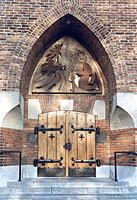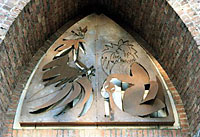
St. Peter, Leiden
 In 1996 Prinsen was invited by the church council to make a design for
the tympanum. This resulted in a vaulted relief made in cortensteel, depicting
the passing of the keys to heaven from Christ to Peter. The two keys symbolise
the situation of man between the real and the ideal, constantly working with opposite
forces of creation.
In 1996 Prinsen was invited by the church council to make a design for
the tympanum. This resulted in a vaulted relief made in cortensteel, depicting
the passing of the keys to heaven from Christ to Peter. The two keys symbolise
the situation of man between the real and the ideal, constantly working with opposite
forces of creation.
Two keys are given to Peter, a worldly and a spiritual one: whatever is opened up in the world shall also transpire in the heavenly realm, likewise that which is put to an end and closed off in the worldly realm shall cease to be in heavenly space. The double key reveals the mystery of the earth. <-p>
 The
tympanum is the semicircular or triangular area above the lintel (piece of stone
over the door). Prinsen filled this space with a vaulted relief in cortensteel.
It depicts the moment Christ hands the keys to heaven over to Peter. The Christ
figure is represented as a spiritual entity whereas Peter is shown as a robust
fisherman.
The
tympanum is the semicircular or triangular area above the lintel (piece of stone
over the door). Prinsen filled this space with a vaulted relief in cortensteel.
It depicts the moment Christ hands the keys to heaven over to Peter. The Christ
figure is represented as a spiritual entity whereas Peter is shown as a robust
fisherman.
The church of St Peter was built in the thirties of the twentieth century, after the destruction of the old church by fire. Its architect was Kropholler, well known in Holland for his robust neo-Roman style and frequent use of forged iron.
The reference to medieval churches shows itself in the positioning of the tympanum above the main entrance. Traditionally this was the space for sculpture and Kropholler's design clearly shows that he projected a stone sculpture in the vault. For some reason however the tympanum remained empty when the church was completed.
Website © Irène Prinsen, visitors of this site are reminded that the exhibited works and commentaries are subject to copyright law. For use of works of visual artists affiliated with a CISAC-organisation, other than consultation via Internet, permission is required from Pictoright, visuele auteursrechten Nederland.